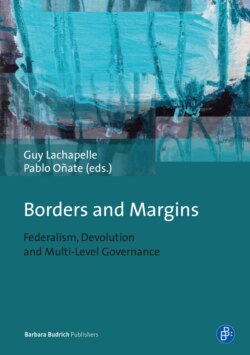Читать книгу Borders and Margins - Группа авторов - Страница 23
На сайте Литреса книга снята с продажи.
[40] MLG in the European Union and Intergovernmental Relations in the US
ОглавлениеThere are also some valuable insights to be gained by conducting a direct comparison of the governance patterns of MLG in the European Union and the patterns of internal intergovernmental relations in American federalism. Such a comparison was made recently by Edoardo Ongaro et al., eds. in their Governance and Intergovernmental Relations in the European Union and the United States: Theoretical Perspectives (2010). In their Introductory chapter, they define “intergovernmental relations” as the pattern of relations between the federal and other levels of government within the public sector, one that is widely adopted by American practitioners and political scientists. They refer to multilevel governance as “the study of the ‘crossroads of vertical (intergovernmental) and horizontal (state-society) relations,” a general description that is widely embraced by European Union officials and students. Their objective is to “build a [theoretical] bridge between these two academic and practitioner communities and their respective ‘cognitive maps’” (Ongaro et al., eds. 2010:1).
Is it possible to bridge the two very different streams of research into US federalism/intergovernmental relations and EU multilevel governance? Theo A.J. Toonen strongly believes that it is. He argues that the modern MLG model of internal intergovernmental relations and public administration is based on two new major approaches in this economically globalised post-modern age: 1) a focus on multidisciplinary and cross-sectional institutional clusters and 2) concentration on networked regions. MLG can foster “an ability to collaborate in a varied institutional context [by] using member-states, regional and local government institutions as partners and agents for joint policy-making and implementation.” It thereby places greater emphasis on “networks” and on “governance arrangements” than on “hierarchies” and “government” (Toonen 2010: 30). Toonen proposes to combine the perspectives of MLG and IGR by “organising at least part of the European debate on the utility of systems of MLG along American lines.” He proposes to incorporate the US public administration concepts of intergovernmental constitution (IGC), intergovernmental relations (IGR) and intergovernmental management (IGM) into the analysis of the internal intergovernmental relations of the EU.
Toonen also notes perceptively that the simple dichotomy and “juxtaposition of federal and unitary systems breaks down when it has to face the variety of administrative systems that need to be addressed today” (Toonen 2010: 35). “Federalism” is now generally understood to be “an abstract and multi-interpretable concept”. And “unitarism” is likewise viewed as highly contentious and ambiguous in meaning. If one distinguishes the analysis of federal and unitary systems of governance and public administration – the governance perspective – from the study of actual states, then “the actual relative subsystem [41] autonomy within a unitary state might be as large or as small as within a federal structure” (Toonen 2010: 36). He contends that “unitary states may actually operate as federalised systems from a sociological, political or administrative point of view,” which he labels “sociological federalism.” And he argues that “conversely, a governance and administratively-oriented ‘implementation’ federalism within a unitary state structure is also possible,” particularly where there is an “informal, bottom-up ‘participative management’” (Ibid.) In short, according to Toonen (2010:36), “the main a priori difference among unitary and federal states is that due to their different legal frameworks, the relative autonomy of subsystems has a distinctive legal expression.” This may not, however, have important practical consequences. It follows, then, that it is both possible and legitimate to study federal and unitary systems from various conceptual perspectives: sovereign or power theory, network analysis or interdependency theory.
In our view, Toonen’s effort to combine the theoretical perspectives of the IGR and MLG frameworks is promising in its potential contribution to the current debate about the utility of MLG as a comparative analytical tool. We shall consider in the concluding section below to what extent it may be used to gauge the value of the multilevel governance concept in the analysis of intergovernmental relations in the current economically globalised world.
